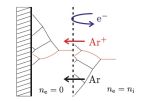EPJ D Highlight - Novel plasma diagnostics method
- Details
- Published on 15 April 2015

Physicists have now devised an elegant plasma pressure diagnostic method by studying forces akin to the pressure change at the inner walls of energy saving light bulb when the light is switched on
Could the mundane action of switching on an energy saving light bulb still hold secrets? It does, at least for physicists. These bulbs are interesting because they contain low-temperature plasma—a gas containing charges from ions and electrons. Now, a German team has developed a method that could be used for measuring the increase in the plasma force on the inner side of such a light bulb when the light is switched on. These findings from Thomas Trottenberg and colleagues from Christian-Albrechts University in Kiel, Germany, have just been published in EPJ D. They have implications for plasma diagnostics concerning plasma-wall interactions used in surface modification and the production of thin film solar cells and microchips.
The team developed a mechanical setup to measure the extremely small force exerted by the plasma on a solid surface. They measured the deflection of a pendulum equipped with a square surface exposed to a plasma. Instead of using a commercial energy saving light bulb, the physicists produced plasma in an 18-liter chamber filled with argon gas.
Experimental results show that the force increases as the plasma density increases and decreases as the gas pressure increases. To explain this phenomenon, Trottenberg and colleagues analysed the relative contributions of the various physical forces present. These forces stem from reflected electrons exerting the electron pressure and from ions entering the thin layer which develops in the plasma between the wall and the plasma, called the sheath. They also stem from the fast-moving argon gas atoms entering the sheath, accelerated by the momentum from previous collisions with ions and between atoms.
This could lead to a promising new kind of plasma diagnostics, providing insights into processes that conventional electrical probes can’t detect.
T. Trottenberg, T. Richter, and H. Kersten (2015), Measurement of the Force Exerted on the Surface of an Object Immersed in a Plasma, Eur. Phys. J. D 69: 91, DOI: 10.1140/epjd/e2015-50743-2





